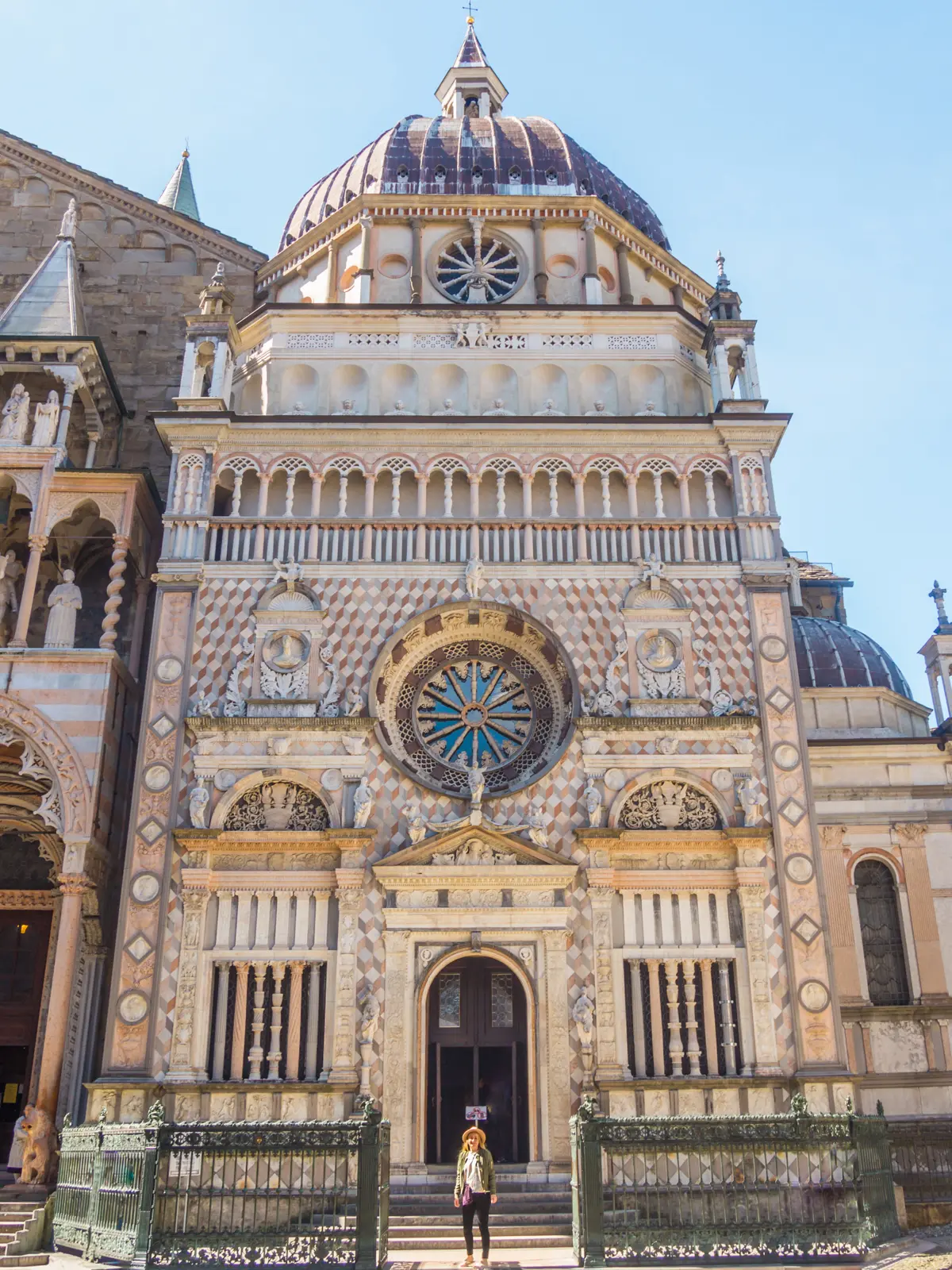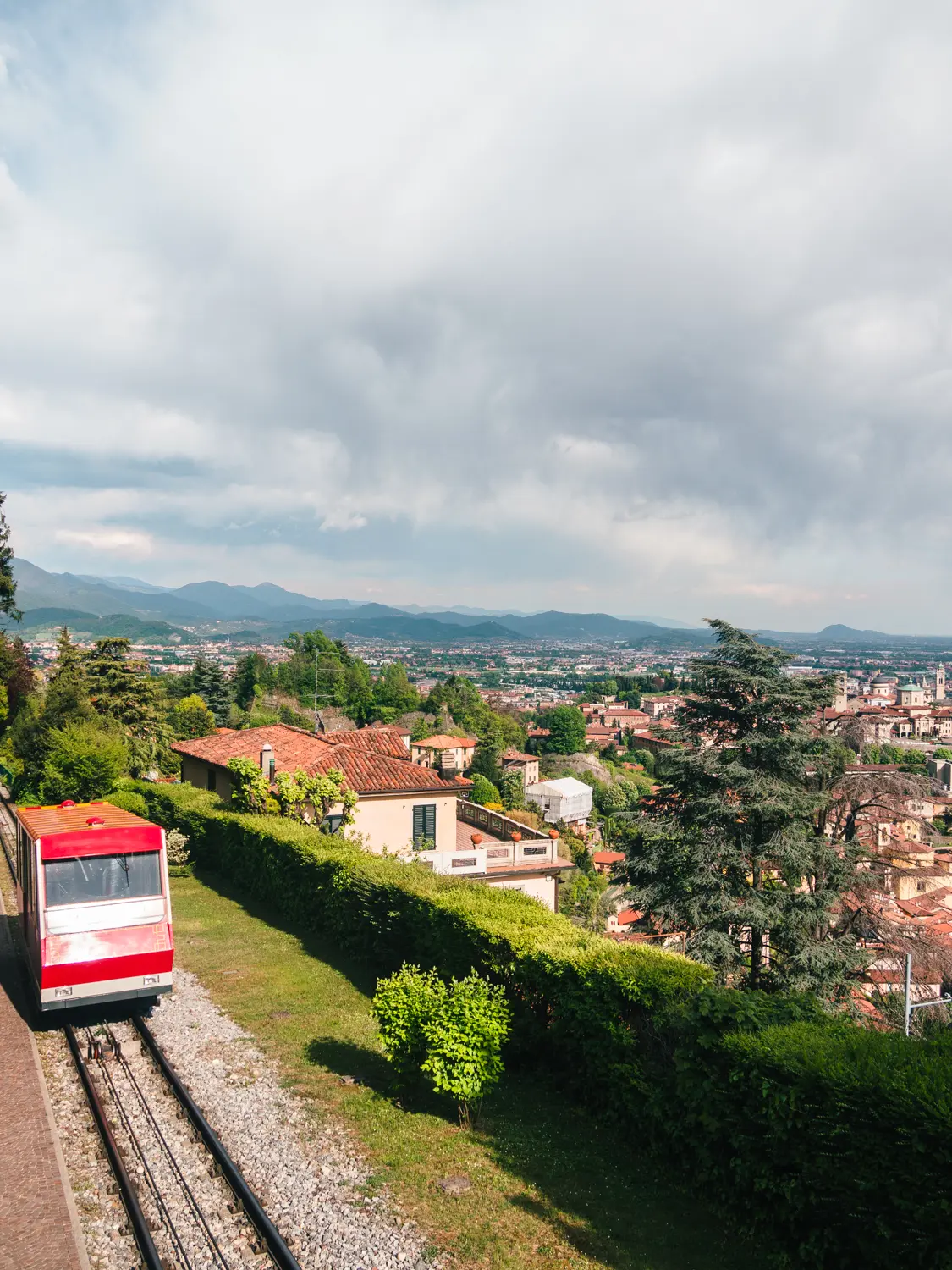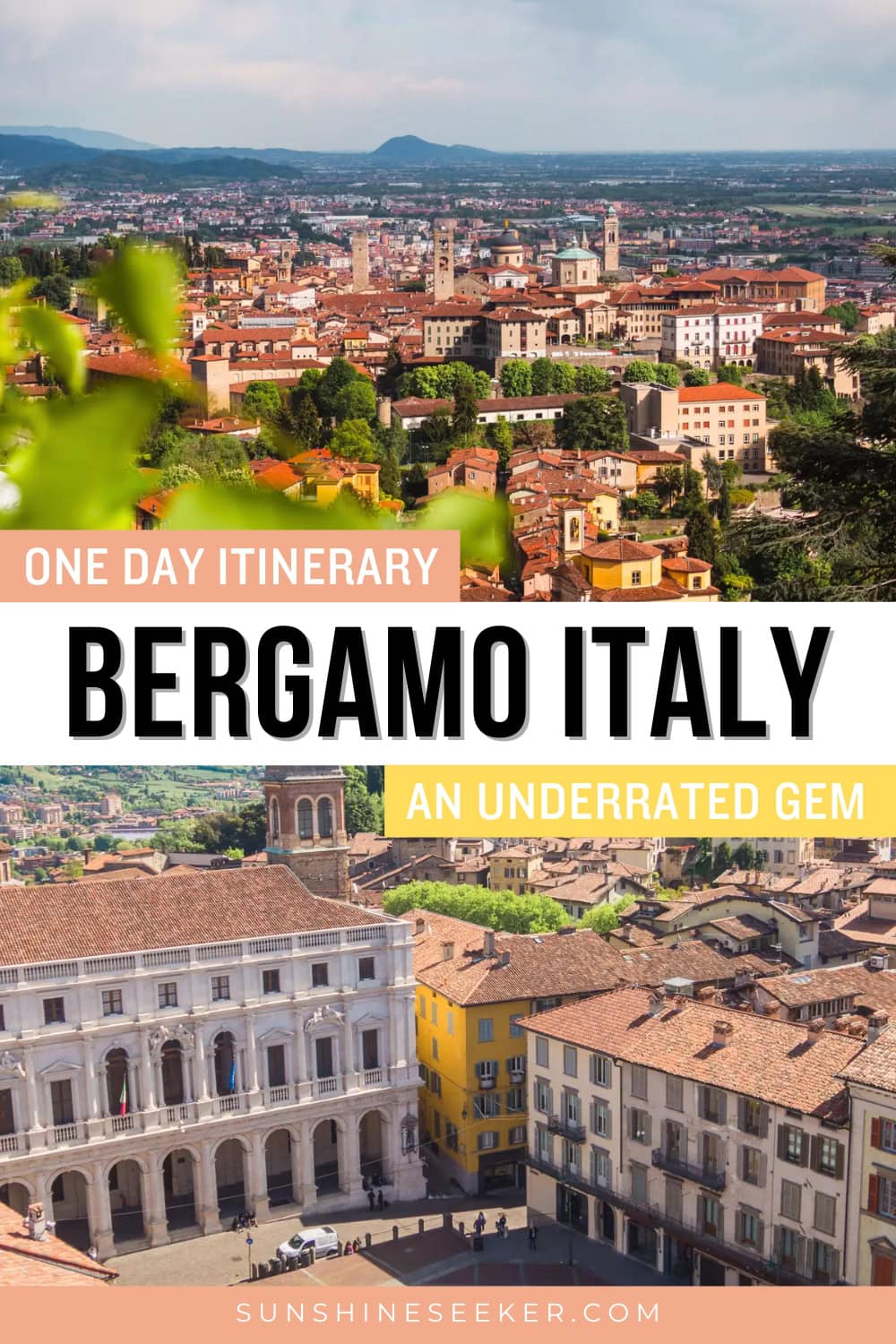Bergamo, an underrated gem in Lombardy, Northern Italy, is often overshadowed by its glamorous neighbors, Milan and Lake Como.
I first visited Bergamo years ago because Ryanair runs a super cheap flight there from my hometown. I think I paid €29 for return tickets.
My original plan was to take a bus from the airport straight to Milan and then continue to the lake after a few days. On a whim, I decided to check out Bergamo’s Old Town as well.
Little did I know that it would end up being the highlight of my entire Italy trip. And I just went back because I loved it so much. So let’s take a closer look at how to spend one perfect day in Bergamo.

Article overview
How to get to Bergamo
Several low-cost carriers, including Ryanair and Wizz Air, fly into Bergamo Orio al Serio Airport, 15 minutes from Bergamo and 45 minutes by car from Milan.
After collecting my luggage, I followed the signs to the bus stop just outside the arrivals terminal. I purchased a ticket for the Airport Bus (Line 1) from the ATB app. But you can also get it from the ticket machine, just remember to validate it on the bus.
I got the 24-hour 3-zone ticket so I could also use the funiculars in Bergamo as well as take the bus from Città Alta down to the train station the next day to continue to Milan.
The buses run to Bergamo train station and the city center, then stop off at Porta Nuova (lower funicular station) and Città Alta. It takes between 15 and 20 minutes to reach the last stop.
🚘 If you prefer a private driver, I always book transfers through Welcome Pickups. They often surprise me with their low prices and great service, so I love supporting them.

One day in Bergamo
Bergamo is uniquely divided into two distinct areas: the historic Città Alta (Upper Town) and the newer Città Bassa (Lower Town).
Città Alta, perched on a hill and surrounded by well-preserved Venetian walls, transports you back in time with its medieval architecture, narrow cobblestone streets and impressive landmarks.
In contrast, Città Bassa boasts a more urban atmosphere with shops, restaurants, cultural venues and a train station. However, since I only had one day in Bergamo on both visits, I decided to focus on the historic part.
🌟 By the way, I stayed in Casa Matin Bergamo and I absolutely loved it!
Piazza Vecchia
Piazza Vecchia, the beating heart of Bergamo’s Città Alta, is the perfect starting point for your day. Surrounded by historic buildings, Palazzo della Ragione and the Civic Tower on one side and the stunning Palazzo Nuovo on the other. I loved sitting down with a snack here, just taking in the atmosphere.
Dating back to the 12th century, the Civic Tower, also known as the Campanone, is one of Bergamo’s most prominent landmarks. Every night at 10:00 pm the bells ring 100 times as a reminder of when the city gates would close back in the day.
The photo above and below are both shot from the top. I climbed up the 230 stairs, which was harder than I anticipated, but you can also take the elevator. Tickets were €7.

Piazza Duomo
After seeing the beautiful view from the bell tower I continued to Piazza Duomo, another square surrounded by some of the most beautiful buildings in Bergamo. I spent at least an hour here in awe of Capella Colleoni in particular.
Cappella Colleoni: This Renaissance masterpiece was built as the mausoleum for the condottiero Bartolomeo Colleoni. The chapel’s striking facade features patterned marble and intricate carvings, reminding me a lot of the architecture in Florence. I could not stop photographing it, with Basilica di Santa Maria Maggiore next to it. Going inside was free, but photography is not allowed.
Basilica di Santa Maria Maggiore: Known for its stunning Romanesque architecture and richly decorated interior. It is up there with the most stunning interiors I’ve ever seen, almost as decadent as St Peters Church in Rome. The ceiling looks like one big jewel.
Bergamo Cathedral: A few steps away stands yet another religious marvel, S. Alessandro Martire Cathedral. There have been cathedrals in this spot since the 9th century, but the Neo-classical façade of white Botticino marble was finished in 1889. Since I had already spent so much time looking at churches I just peeked inside. It is incredibly beautiful and free, so definitely worth it.
Museo Del Tesoro Della Cattedrale: What I found really interesting is that there is a museum below the cathedral showcasing a Roman settlement and parts of earlier cathedrals, discovered during excavations in 2004. In my eyes, it is one of the highlights of Bergamo and tickets only cost €5.

Lunch at Il Fornaio
After hours of exploring, it was time for some food. And all I can say is, do not miss Il Fornaio while in Bergamo!! You can thank me later. The counters, full of different pizzas and focaccia with decadent toppings, luckily caught my eye while walking past.
Since this was early in the day we opted for a huge focaccia to bring out in the sun. We wanted to make the most of our day in Bergamo so we found a place to sit down at Piazza Vecchia and had a little picnic.
I can’t wait to go back for the pizza, it looked unreal. Il Fornaio is always packed so you have to take a number at the door and wait patiently. But that’s a good thing because you’ll need time to decide what to get.


Via Gombito and Via Colleoni
After lunch, I wanted to get away from the crowds and just started walking trying to find some quiet spots. It was fun to walk down all the narrow alleys and just see where I ended up. Well, in Bergamo it seems like all roads lead to Via Gombito and Via Bartolomeo Colleoni.
These two main streets run through the heart of Città Alta and are lined with charming shops, cafes and historic buildings. I walked all the way south and that is how I by chance stumbled upon Palazzo Moroni.
Palazzo Moroni
For my fellow lovers of old-world architecture and interior design, Palazzo Moroni is a must. It is one of the best preserved buildings in Cittá Alta, boasting magnificent Baroque Era frescoes and an impressive art collection.
The Moroni family owned and lived in the palace since 1646. In 2019 it was taken over by FAI, a private non-profit organization, that owns 22 castles, gardens and monastic buildings throughout Italy.
I was also so surprised to see such a large Italian garden complex in the Old Town. I paid €11 for the ticket and spent almost two hours here, so it was well worth it.
Right next to Palazzo Moroni, you also find Rocca di Bergamo, a historic fortress located on a hilltop boasting panoramic views of the city and surrounding countryside.

Funicolare di Bergamo Alta
Waling across Piazza Mercato delle Scarpe on my way to San Giacomo Gate, I noticed that there was almost no queue for the funicular. Since I was staying in Cittá Alta, I didn’t have a reason to ride it down to the lower city, but I really wanted to experience it. So off I went, up and down.
The short but scenic ride offers beautiful views of Bergamo and the Po Valley and is a fun way to navigate between the two parts of the city. It only cost €1.70 each way, but it was also included in my 24-hour public transport ticket.
The funicular dates back to 1887, but the current rail cart was introduced in 1917.
If you’re hungry, this is a great time to stop by Polentone on Piazza Mercato delle Scarpe and taste one of Bergamo’s delicacies, Polenta Taragna.

San Giacomo Gate & the Venetian Walls
After my swift ride on the funicular, I made it to San Giacomo Gate, or Porta San Giacomo, the most iconic entrance to Città Alta. It was constructed in the 16th century, during the Venetian rule, as part of the walls that encircle the historic upper town.
Right behind San Giacomo Gate, you’ll also see Medolago Albani Palace, one of the most striking Neoclassical buildings in Bergamo. Built in the late 1700s, it is still a private residence today.
The Venetian Walls themselves stretch for over six kilometers and are a UNESCO World Heritage site. I walked along them all the way back up to Sant’Alessandro Gate, marveling at the breathtaking views. It took about 25 minutes with a few stops, but you can also take bus no. 1.


Castello di San Vigilio
The last stop on this Bergamo itinerary is San Vigilio Hill and castle by the same name, which is also reached by a funicular. The castle ruins and surrounding park provide a lovely setting for a leisurely walk or picnic. From the top, you can enjoy panoramic views of Bergamo, the Po Valley and the Alps in the far distance.
🍕 Pro tip >> If you’re visiting during the warmer months, sit down for a sunset dinner on the beautiful veranda of Ristorante Pizzeria San Vigilio. The food is good but the views are even better. I’ve only been here when it was cold out, but I can only imagine how gorgeous it is during sunset when everything is green.

Bergamo for the foodies
Bergamo is renowned for its rich and hearty cuisine, deeply rooted in its Lombard heritage and characterized by the use of local, high-quality ingredients.
One of the standout dishes I had been looking forward to trying is Casoncelli alla Bergamasca, a type of stuffed pasta similar to ravioli. It is often filled with a savory mixture of meats, breadcrumbs, and cheese, and traditionally served with a butter and sage sauce, often garnished with pancetta and grated Parmesan.
Scarpinocc is another hand-folded dumpling, but this is filled with Taleggio, a washed rind cow’s milk cheese. It was popular among the farmers back in the day because of the few ingredients needed.
Additionally, Bergamo is famous for Polenta Taragna made from a blend of cornmeal and buckwheat flour, cooked to a creamy consistency with local cheese, such as Taleggio or Branzi. I tried it with pulled pork at Polentone which I highly recommend.
Another local favorite is Polenta e Osei, a unique dessert that mimics the appearance of polenta but is actually made from sponge cake, chocolate, and marzipan, adorned with tiny marzipan birds.
Oh, and did you know Bergamo is the birthplace of Stracciatella gelato? It is generally not my favorite, but of course, I had to try it at La Marianna while in town. And it was delicious.
Lastly, if you can’t get enough of sweets, try Torta Donizetti, a ring-shaped cake named after the famous composer Gaetano Donizetti, made with apricots and pineapple.

Is tap water ok to drink in Bergamo?
I have seen this question a lot, and yes, the tap water in Bergamo is safe to drink. In fact, it is very high quality because it comes straight from the mountains.
Italy, in general, has stringent regulations for water quality, and the tap water in most cities meets these standards. I read somewhere that it is up there with the best in Europe.
However, I like to travel with my LifeStraw bottle no matter what. Because then I can fill it up anywhere without thinking twice about it.
🌟 LifeStraw Go Water Filter Bottle
My favorite bottle for travel, backpacking and hiking.
You can fill it up anywhere, LifeStraw filters bacteria, parasites, chemicals and microplastics.
For every LifeStraw product purchased, a child in need receives safe water for an entire school year!
Is Bergamo worth visiting?
Yes, very much so! I think it is one of the most underrated cities in Italy.
Which is better, Milan or Bergamo? As someone who isn’t a fan of big cities, the highlight for me was Bergamo. I love that everything is within easy walking distance and the calm atmosphere.
Of course, Milan boasts many grand landmarks, some of the best shopping in the world and a more vibrant nightlife. So it all depends on what you’re after. But ideally, visit both and decide for yourself.
🌟 Read next >> How to spend two perfect days in Milan Italy











Wow this is the BEST account of a visit to Bergamo I’ve seen yet. Very much on my wavelength and vibing with how I like to explore a place with a view for art, beauty and adventure. I’ll be going for a week very soon and plan to do very very similar, benefitting from your great tips, but (as this was a one-day account) I plan to mine seven times slower!! Ha ha. With a few langourous cafe visits included and hopefully a day trip to Lake Iseo somewhere along the line.
But anyway, thank you Charlotte. I have to say it again. The best account of a visit to Bergamo!!
Thank you so much for your kind words, David! It means a lot to me. I’m sure you’ll have a great time! I’ll definitely be back for a longer stay soon too 😊